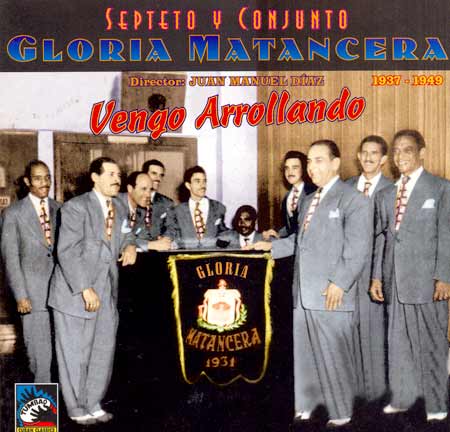9.10.5 The Matanzas Glory

La Gloria Matancera, a prominent Cuban popular dance music group founded on June 3, 1927, in the city of Matanzas by Juan Manuel Díaz Clemente. The group was formed as a septet instrumental group. It consisted of its director and his three brothers: Carlos (Tres), Eliseo (Güiro), and Eliodoro (maracas and vocals).
Other members of the septet were Aurelio Hernández (trumpet), Mario Coll (double bass) and José Luis González (bongo and pailas).
The orchestra was known only in its hometown, where it became very popular, performing in every dance hall. With the rise of Son music in 1930, La Gloria Matancera moved to the Cuban capital to fulfill a work contract.
A year later, with the aim of expanding their artistic horizons, the Matanzas septet moved to Havana. In this city, they gained great notoriety and consolidated their prestige within Cuban music. At that time, they alternated their performances with the most important groups and also accompanied the best soloists of the time. They could be found in various venues, but especially at the popular Alambra Theater.
Under the PANART label, in 1940, as a result of the resounding success achieved both in Cuba and abroad, La Gloria Matancera recorded their first album. It featured songs such as “Para que sufrin los pollos” (For the Chickens to Suffer) and “Okana Sordi.” They later recorded other productions with RCA Víctor and other prestigious international record labels.
At that time, the septet changed its format to an ensemble, specifically in 1944, in keeping with the trends of that decade. This instrumental format consisted of piano, congas, timbalitos, double bass, two trumpets, güiro, and singers.
Already in the 1950s, La Gloria Matancera was one of the Cuban groups that enjoyed the public’s preference.
In 1992, upon the death of its director and founder, his son Arístides Emiliano Díaz Almeida, known as Tillo, took over the direction of the group.
In 2007, the group transformed its format again by adding a trumpet, thus forming the instrumental format it boasts today: piano, two congas, güiro, three trumpets, three singers and bongo.
Currently, La Gloria Matancera is made up of twelve excellent musicians, including Bárbaro López, Carlos Amores, Israel Díaz and Yamilé González (singers); Luís A. Luque (bongo); Patricio Matienzo (congas); Luís M. Cuellar (piano); Humberto Vergara (trumpet); Andrés Hernández (trumpet); José G. Fernández (trumpet); among others.
Voices such as those of Merceditas Valdés, Roberto Sánchez, Fernando Álvarez, and Abelardo Barroso have joined the band to deliver excellent performances. Much of the repertoire they showcase in their performances is composed by musicians who have been part of La Gloria Matancera over the years. Among the songs performed by this Cuban orchestra that have achieved great success are “You Will Carry the Brand,” “Ratón de Velario,” “Oye Chachareo,” “Camanitas de Cristal,” and “Sube la Bolita.”
On its eightieth anniversary, the Gloria Matancera Ensemble was honored at the Salón Rosado de la Tropical (41st and 46th Avenues, Playa, Havana). Among the accolades this renowned Cuban ensemble has garnered, we can mention La Gitana Tropical, a distinction from the Cuban Institute of Music for its 75th anniversary.
La Gloria Matancera preserves its original repertoire, while also displaying a distinctive sound and timbre—elements that constitute its signature. It is considered by critics, specialists, and musicologists to be one of the most important Cuban orchestras of all time.








